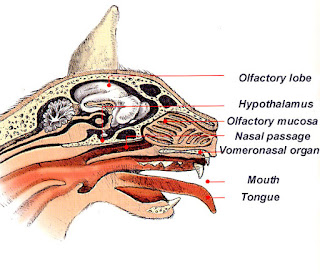Yes, "on" catnip. I speak of it like a drug, because it is.
Sure, make a laser pointer dance around the room and you've got endless hours of entertainment. But give Mittens a little toy mouse infused with catnip and—well, something changes.
Mittens will rub against the toy, rolling around and ecstatically chewing it. She may drool and become either sleepy or anxious. If you try to take the toy, she might act aggressive, scratching or biting at you.
Forget the mouse—Mittens wants the catnip inside. So what is catnip, and why is it causing your sweet kitty to behave so dichotomously?
What is catnip?
Catnip, also called catswort or catmint, is a plant of the genus Nepeta. Native to Asia and Europe, it's become common worldwide—in fact, you're likely to see it growing along many North American highways and railroads. Catnip is a relative of oregano and spearmint.
In the past, humans consumed the plant in the form of juice, tea, alcohol, or by smoking—for medicinal purposes such as pain, insomnia, colic, and, er, flatulence.
In the past, humans consumed the plant in the form of juice, tea, alcohol, or by smoking—for medicinal purposes such as pain, insomnia, colic, and, er, flatulence.
What is it doing to my cat?!
The toys that drive our feline friends crazy contain either Nepeta leaves or its oil extract, called nepetalactone.
Nepetalactone is believed to mimic a cat pheromone, a chemical secreted by an animal that triggers social behavior in members of the same species. Most animals, it is thought, have the ability to secrete and detect pheromones, whether or not the behavior is conscious.
 |
| Nepetalactone. Blame everything on this. |
In cats, for instance, some speculate that there may be a feline facial pheromone (try saying that five times fast)—a specific chemical transferred from the face when cats rub against objects. And, hey, cats seem to do that a lot. Although this seems like a plausible hypothesis, it is not known whether this pheromone actually exists.
Regardless, we know that nepetalactone acts as an attractant in two-thirds of cats, and its effectiveness is hereditary. So if Momma Cat and Papa Cat don't care much for catnip, Mittens will probably be indifferent, too.
When the scent of the oil enters the cat's nasal tissue, it binds to receptors, which stimulate sensory neurons. These neurons act on the olfactory bulb, which projects to many regions of the brain.
Notably, projections to the amygdala, located in the midbrain, mediate emotional responses. Another projection, to the hypothalamus, is thought to activate the pituitary gland, resulting in a sexual response.
So...yeah. All that rolling around, nipping, scratching, drooling—Mittens thinks she's in the presence of Mr. Winkles oozing his delicious pheromones.
The best part about catnip that it affects not just domestic felines, but also the big cats. That's right—giant mountain lions rubbing around with no regard for their dignity or surroundings.
Just, er, stay far away should you ever witness that. I hear they weigh a lot and their teeth are rather sharp.
Arthur O. Tucker and Sharon S. Tucker (1988). Catnip and the catnip response. Economic Botany, 42 (2), 214-231 DOI: 10.1007/BF02858923
Arthur O. Tucker and Sharon S. Tucker (1988). Catnip and the catnip response. Economic Botany, 42 (2), 214-231 DOI: 10.1007/BF02858923






No comments:
Post a Comment
I appreciate all comments and strongly encourage discussion on the topics I write about! Please be respectful to me and other readers. Spam comments will not be published.